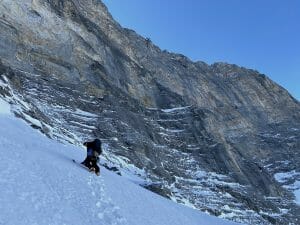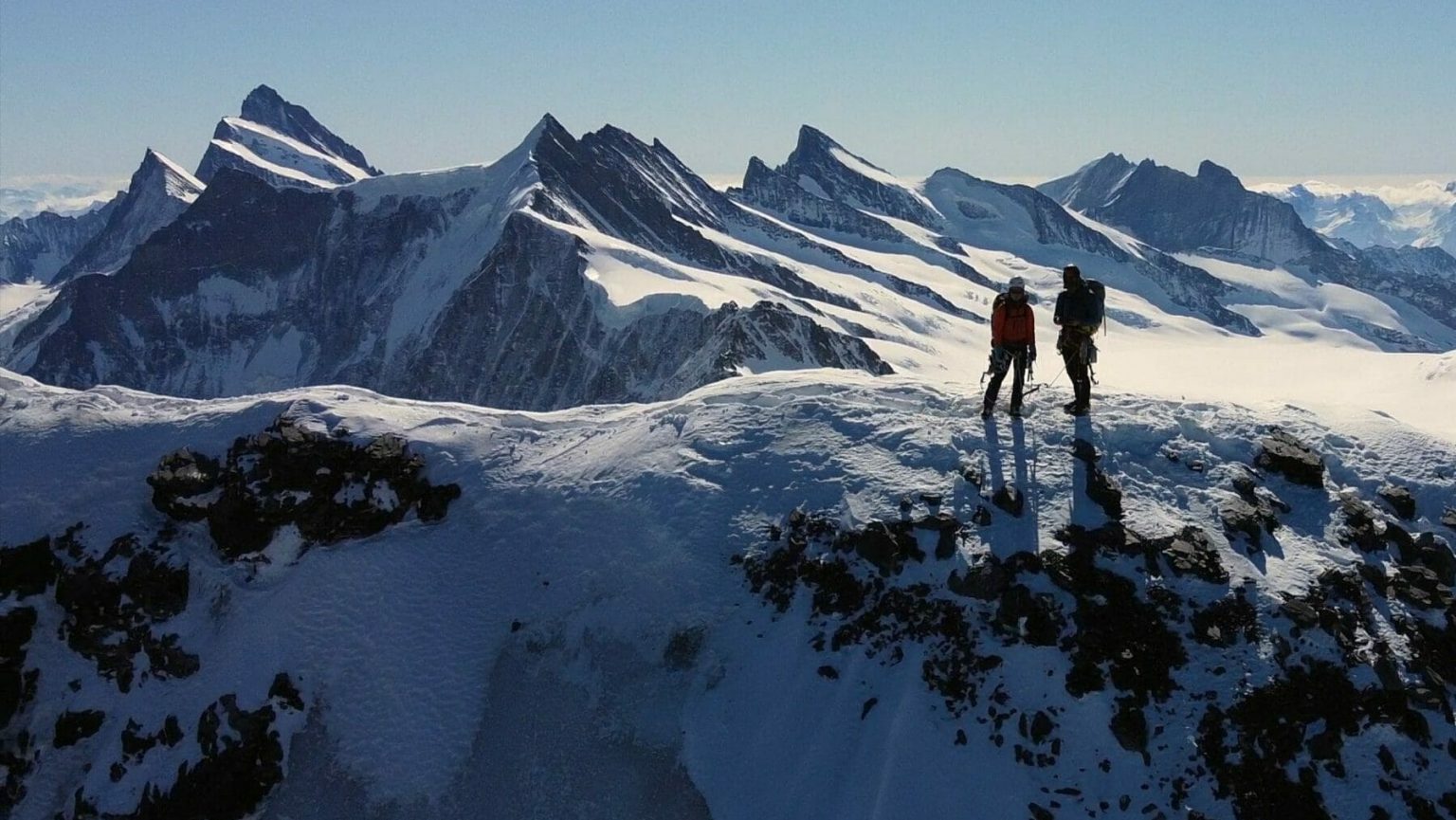The year 2020 has been a Sabbatical for married Alpinists Jeff and Priti Wright. As a full-time Engineer and Software Developer, their alpine pursuits have been relegated to three weeks of vacation per year. Making good use of those precious vacation days, in the past five years they’ve managed squeeze in the Cassin Ridge on Denali, All Along the Watchtower in the Bugaboos, Fitz Roy in Patagonia, the Southern Pickets Traverse (2nd Ascent), The Nose-in-a-Day and Salathé on El Capitan, Mount Waddington, Mont Blanc, Cerro Torre, and most recently The Eiger (just before Lockdown).
“Anyone who returns from the Eigerwand cannot but realize that he has done something more than a virtuoso climb: he has lived through a human experience to which he had committed not only all his skill, intelligence and strength, but his very existence.”
-Lionel Terray, Conquistadors of the Useless
The first two months of our 2020 Sabbatical were committed to living in El Chaltén in Argentine Patagonia (our fourth trip to the massif), which invariably meant a lot of time spent in town with bad Patagonian weather. Trying to spend an entire season in El Chaltén, one can go really stir crazy! It’s tempting to travel to some of South America’s fine cragging destinations while waiting for good weather on Fitz Roy or Cerro Torre, but this itinerary risks the Alpinist missing out when a great big weather window unexpectedly hits the Chaltén massif.
These two months in El Chaltén provided a fantastic opportunity to work on our Aerobic Capacity, which was briefly interrupted by an ascent of Cerro Torre by the Via dei Ragni route (sorry Scott!).
We’ve employed several Uphill Athlete Plans in the past with great success such as Steve House’s Advanced Ice and Mixed Climbing, Josh Wharton’s Rock Climbing plans, 16-Week Big Mountain, and devoured both Uphill Athlete books.
While in El Chaltén January and February, we started Steve House’s Eiger North Face Training Plan. We would spend March through June in Chamonix, France and The Eiger was one of our primary objectives in the Alps. While we were already technically competent enough to tackle the moderate terrain that the 1938 Heckmair Route demands, we knew that we were still Aerobically Deficient. The thing we love about this training plan is not only does it include interesting Ice-specific drills and also Muscular Endurance (key for a long, technical climb), but it still focuses on building the Aerobic Base.

Years of listening to Scott and Steve has unwillingly reconditioned us to accept the necessity of Aerobic Capacity training in order to support the high volume of aerobic work required on long alpine climbs like the Nordwand.
Once technically competent enough to climb the level of ice, mixed, and rock required for The Eiger, the difference between a slow ascent and a fast ascent (in large part) depends on the climber’s Aerobic Base. Still for us, it is useful to consistently stay humble and admit to ourselves that we are Aerobically Deficient. Those unsexy long, slow runs and uphill weighted walks are really our best ally for alpine climbing, and we just can’t get enough of them.
Watching our Aerobic Threshold increase on a weekly basis is one of the most rewarding training feedbacks. The correlating performance improvement of Aerobic Capacity training in the alpine is invaluable.
By mid-March, an extraordinarily large weather window was approaching The Eiger. There is no other mountain we can think of that is more temperamental about weather and fussy about conditions, so when a big weather window approaches, you have to at least go look at the thing! We figured we’d at least go understand the logistics and get an idea of conditions. Steve House compiled some excellent beta on the Heckmair Route which got us inspired and informed.

Among the reasons we climb, isolation is not one of them. But we did happen to have one of the most isolated experiences on the North Face during the COVID-19 crisis. While Switzerland still to this day has not implemented a Lockdown, trains and ski resorts unexpectedly closed in mid-March just as we arrived in Grindelwald. This turn of events meant that without the Jungfrau train in operation, we were forced to skin up an extra 6 miles (9.6km) and 4500ft (1370m) up to the Eigergletscher from Grindelwald (a mere “sit-start”).
The Jungfrau ski resort sits at the foot of The Eiger and is usually a cacophony of ski lift machinery, cow bells in warmer months, jubilant skiers, and trains (a critical component to the logistical Approach to the North Face).
Jon Krakauer wrote in Eiger Dreams: “I didn’t want to climb the Eiger, I wanted to have climbed the Eiger.” This is a sentiment I think most climbers can understand at some level. For years this quote has haunted us. There are many climbs to which we could solidly attribute this feeling. We knew, however, that whenever we would finally step out onto the snowy slopes of The Eiger, we didn’t want to have this feeling. The Eiger is just too dangerous and too big to not want to be there. We wanted to be in it, and enjoy wrestling with the alligator.
Back in France, the Chamonix-Mont-Blanc lifts were still operating normally and the country was not in Lockdown, so we decided to stay in Grindelwald and take advantage of the high pressure system. With Steve’s training and beta plus a splitter weather window, the entire climb went off without a hitch. The Difficult Crack is truly difficult (and also hard to find…and also not a crack)! The Difficult Crack is the start of the technical terrain. After the Difficult Crack, the remainder of the route finding on the Heckmair is relatively straightforward, following major terrain features.

The incredible skill and bravery of the original climbers of the 30’s and 40’s is absolutely mind-bending. Those guys were total badasses! Nowadays, Meteo Swiss provides reliable forecasts, and the helicopter company Air Glaciers will happily pluck distressed climbers off the North Face with confident mastery.
At the Death Bivouac, we dug out a platform under a narrow overhang. Surprisingly, our ledge was just wide enough to (uncomfortably) sleep side-by-side… an unexpected luxury. We each brought a three-quarter length inflatable ‘summer’ sleeping pad for the wintery conditions on the North Face. But while brewing up dinner, Jeff was horrified to discover that his sleeping pad would not stay inflated. Therefore, Jeff passed the nights on The Eiger in sub-freezing temperatures on narrow ledges with only ropes and backpacks under his ass!
Finally escaping the shadow of the North Face, the sunlight on the summit ridge was a warm welcome. The sheer verticality of the Eigerwand was behind us, and we walked down the Western Flank of the mountain down to Eigergletscher Station. A final victory ski lap down the deserted ski resort deposited us back to Grindelwald. France had just gone into mandatory Lockdown, so we drove the 3-hours back to Chamonix to commence our long spell of quarantine.
Our Gap Year
- January-February: El Chaltén, Argentina to get our butts kicked in the finest collection of peaks on the planet.
- March-June: Chamonix, France to train and hone the alpine skills in the world’s alpine playground.
- July-September: Karakoram, Pakistan. Show time! Try to do something big.
- October-December: Southeast Asia to sit back and clip some bolts (and put our feet in the sand).
The Socials
Follow along on Instagram:
Keep up-to-date with our blog: www.alpinevagabonds.com
Full Trip Report: https://alpinevagabonds.com/the-eiger-north-face/
Current Status
As we type here in April 2020, we are currently holed up in our Chamonix bunker under mandatory nationwide French lockdown from March 20 through May 11 (if it doesn’t get extended). We’re still hopeful that we can get to Pakistan in July. As of now, none of our Sabbatical plans have changed.
We’re currently in another Base Period of training for our upcoming trip to Pakistan.

